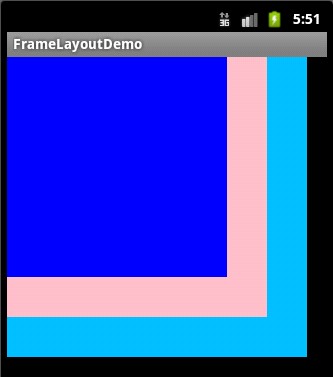Android五大布局
2016-05-18 09:21
429 查看
一、线性布局LinearLayout
包含的子控件将以横向或者竖向的方式排列
LinearLayout本身常用的两个属性
android:orientation = “vertical”
--------该属性决定子类控件的排布方式(vertical垂直 horizontal水平)
android:gravity = “center”
--------该属性决定子类的xy位置(常用的属性值如下:)
1.center_gravity:垂直居中
2.center_horizontal:水平居中
3.center:水平垂直居中
4.right:子类控件位于当前布局的右边
5.left:子类控件位于当前布局的左边
6.bottom:子类控件位于当前布局的下面
子类控件在LinearLayout中常用的属性
android:layout_gravity = "bottom" -------指本身在当前父容器的XY的一个位置
android:layout_weight = "1"-------指本身控件占父容器的比例
如果将布局高度按比例分配,如果android:layout_height="match_parent"值为match_parent,则表示按反比分配
android:layout_height="wrap_content"值为wrap_content表示按比例分配
二、相对布局RelativeLayout
包含的子控件将以控件之间的相对位置或者子类控件相对父类容器的位置的方式排列
子类控件在RelativeLayout中常用的属性(相对父类容器的一个位置)
android:layout_alignParentLeft = "true"子类控件相对父类容器靠左边
android:layout_alignParent = "true"子类控件相对父类容器靠上边
android:layout_marginLeft = "40dp"子类控件距离父类容器靠左边的距离
android:layout_marginTop = "40dp"子类控件距离父类容器靠上边的距离
android:layout_centerHorizontal = "true"子类控件相对父类容器水平居中
android:layout_centerVertical = "true"子类控件相对父类容器垂直居中
子类控件相对子类控件的一个位置
android:layout_below = "@+id/button1"该控件位于给定id控件的底部
android:layout_toRightOf = "@+id/button1"该控件位于给定id控件的右边
android:layout_above = "@+id/button1"该控件位于给定id控件的上面
android:layout_toLeftOf = "@+id/button1"该控件位于给定id控件的左边
android:layout_alignBaseline= "@+id/button1"该控件的内容与给定id控件的内容在一条线上
android:layout_alignBottom = "@+id/button1"该控件的底部边缘与给定id控件的底部边缘对齐
android:layout_alignRight = "@+id/button1"该控件的右边边缘与给定id控件的右边边缘对齐
android:layout_top = "@+id/button1"该控件的顶部边缘与给定id控件的顶部边缘对齐
三、帧布局FramLayout
帧布局是从屏幕的左上角(0,0)坐标开始布局,多个组件层叠排列,第一个添加的组件放到最底层,最后添加到框架中的视图显示在最上面。上一层的会覆盖下一层的控件。
简单的例子
①效果图:

② 核心代码:
main.xml
<?xml version="1.0" encoding="utf-8"?>
<FrameLayout xmlns:android="http://schemas.android.com/apk/res/android"
android:layout_width="fill_parent"
android:layout_height="fill_parent"
>
<TextView
android:layout_width="300dp"
android:layout_height="300dp"
android:background="#00BFFF"
/>
<TextView
android:layout_width="260dp"
android:layout_height="260dp"
android:background="#FFC0CB"
/>
<TextView
android:layout_width="220dp"
android:layout_height="220dp"
android:background="#0000FF"
/>
</FrameLayout>
四、表格布局
表格布局是一个ViewGroup以表格显示它的子视图(view)元素,即行和列标识一个视图的位置。
表格布局常用的属性如下:
android:collapseColumns:隐藏指定的列
android:shrinkColumns:收缩指定的列以适合屏幕,不会挤出屏幕
android:stretchColumns:尽量把指定的列填充空白部分
android:layout_column:控件放在指定的列
android:layout_span:该控件所跨越的列数
简单的列子:
①效果图:

② 核心代码:
main.xml
<?xml version="1.0" encoding="utf-8"?>
<TableLayout xmlns:android="http://schemas.android.com/apk/res/android"
android:layout_width="fill_parent"
android:layout_height="fill_parent"
>
<TableRow>
<Button
android:text="Button1"
/>
<Button
android:text="Button2"
/>
<Button
android:text="Button3"
/>
</TableRow>
<TableRow>
<Button
android:text="Button4"
/>
<Button
android:layout_span="2"
android:text="Button5"
/>
</TableRow>
</TableLayout>
五、 绝对布局
绝对布局通过指定子组件的确切X,Y坐标来确定组件的位置,在Android2.0 API文档中标明该类已经过期,可以使用FrameLayout或者RelativeLayout来代替。
包含的子控件将以横向或者竖向的方式排列
LinearLayout本身常用的两个属性
android:orientation = “vertical”
--------该属性决定子类控件的排布方式(vertical垂直 horizontal水平)
android:gravity = “center”
--------该属性决定子类的xy位置(常用的属性值如下:)
1.center_gravity:垂直居中
2.center_horizontal:水平居中
3.center:水平垂直居中
4.right:子类控件位于当前布局的右边
5.left:子类控件位于当前布局的左边
6.bottom:子类控件位于当前布局的下面
子类控件在LinearLayout中常用的属性
android:layout_gravity = "bottom" -------指本身在当前父容器的XY的一个位置
android:layout_weight = "1"-------指本身控件占父容器的比例
如果将布局高度按比例分配,如果android:layout_height="match_parent"值为match_parent,则表示按反比分配
android:layout_height="wrap_content"值为wrap_content表示按比例分配
二、相对布局RelativeLayout
包含的子控件将以控件之间的相对位置或者子类控件相对父类容器的位置的方式排列
子类控件在RelativeLayout中常用的属性(相对父类容器的一个位置)
android:layout_alignParentLeft = "true"子类控件相对父类容器靠左边
android:layout_alignParent = "true"子类控件相对父类容器靠上边
android:layout_marginLeft = "40dp"子类控件距离父类容器靠左边的距离
android:layout_marginTop = "40dp"子类控件距离父类容器靠上边的距离
android:layout_centerHorizontal = "true"子类控件相对父类容器水平居中
android:layout_centerVertical = "true"子类控件相对父类容器垂直居中
子类控件相对子类控件的一个位置
android:layout_below = "@+id/button1"该控件位于给定id控件的底部
android:layout_toRightOf = "@+id/button1"该控件位于给定id控件的右边
android:layout_above = "@+id/button1"该控件位于给定id控件的上面
android:layout_toLeftOf = "@+id/button1"该控件位于给定id控件的左边
android:layout_alignBaseline= "@+id/button1"该控件的内容与给定id控件的内容在一条线上
android:layout_alignBottom = "@+id/button1"该控件的底部边缘与给定id控件的底部边缘对齐
android:layout_alignRight = "@+id/button1"该控件的右边边缘与给定id控件的右边边缘对齐
android:layout_top = "@+id/button1"该控件的顶部边缘与给定id控件的顶部边缘对齐
三、帧布局FramLayout
帧布局是从屏幕的左上角(0,0)坐标开始布局,多个组件层叠排列,第一个添加的组件放到最底层,最后添加到框架中的视图显示在最上面。上一层的会覆盖下一层的控件。
简单的例子
①效果图:

② 核心代码:
main.xml
<?xml version="1.0" encoding="utf-8"?>
<FrameLayout xmlns:android="http://schemas.android.com/apk/res/android"
android:layout_width="fill_parent"
android:layout_height="fill_parent"
>
<TextView
android:layout_width="300dp"
android:layout_height="300dp"
android:background="#00BFFF"
/>
<TextView
android:layout_width="260dp"
android:layout_height="260dp"
android:background="#FFC0CB"
/>
<TextView
android:layout_width="220dp"
android:layout_height="220dp"
android:background="#0000FF"
/>
</FrameLayout>
四、表格布局
表格布局是一个ViewGroup以表格显示它的子视图(view)元素,即行和列标识一个视图的位置。
表格布局常用的属性如下:
android:collapseColumns:隐藏指定的列
android:shrinkColumns:收缩指定的列以适合屏幕,不会挤出屏幕
android:stretchColumns:尽量把指定的列填充空白部分
android:layout_column:控件放在指定的列
android:layout_span:该控件所跨越的列数
简单的列子:
①效果图:

② 核心代码:
main.xml
<?xml version="1.0" encoding="utf-8"?>
<TableLayout xmlns:android="http://schemas.android.com/apk/res/android"
android:layout_width="fill_parent"
android:layout_height="fill_parent"
>
<TableRow>
<Button
android:text="Button1"
/>
<Button
android:text="Button2"
/>
<Button
android:text="Button3"
/>
</TableRow>
<TableRow>
<Button
android:text="Button4"
/>
<Button
android:layout_span="2"
android:text="Button5"
/>
</TableRow>
</TableLayout>
五、 绝对布局
绝对布局通过指定子组件的确切X,Y坐标来确定组件的位置,在Android2.0 API文档中标明该类已经过期,可以使用FrameLayout或者RelativeLayout来代替。
相关文章推荐
- Android与服务器端数据交互(基于SOAP协议整合android+webservice)
- Android开发之基于AndroidStudio环境搭建和工程创建
- Android 联网提示Dialog,提升用户体验。
- Android TextView(EditView)文字底部或者中间 加横线
- 关于Android RenderScript 的详细说明和一些实用文档
- android 属性动画
- Android发送短信解决字数限制问题
- 四:资讯列表实现(借助PullToRefres实现上拉和下拉刷新)
- Android 获取屏幕尺寸与密度
- 关于android中位运算的一些看法
- android开发之各种字体控件颜色
- <Android学习笔记二>——Handler的实现
- <Android学习笔记一>——AsyncTask实现
- android 图片上传到服务器
- Android 关于IPC机制的理解(二)
- 在Android上打造属于自己的Rxjava框架(一)基础篇
- Android Intent最全面的解析
- Android官方开发文档Training系列课程中文版:OpenGL绘图之环境配置
- Android中View(视图)绘制不同状态背景图片原理深入分析以及StateListDrawable使用详解
- Android 制作简易浏览器源码
